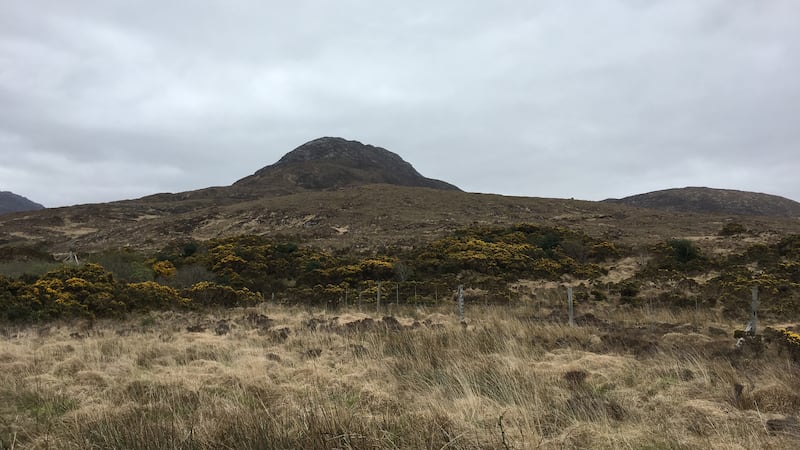At the last thatched cabin on the hill, the roof was beginning to bow. Inside, at the wake, the deceased was correspondingly well-weathered.
We shuffled around to wish him well, then gave others room, all taking care not to bump a central post in the dark. An improvised prop, it supported the roof’s gnarled purlins of bog-deal, dug up from the mountain long ago.
A memory from half a century ago, this surfaces on November 5th – Bonfire Night. In Mayo now, the last ramparts of bog-deal, piled at the margins of fields cleared from peatland, are darkening in November rain.
Perhaps it will all be burned now, this gift of fierce fuel, but the resurrected timber of Connacht’s bogs once built the roofs of countless homes, set a blaze at the heart of reluctant turf fires, and even lit the lives of those sitting beside them.
Michael Viney: Why I moved to Mayo in 1977 and never came back
Michael Longley: ‘Most men don’t like intelligent women. I just hang on their every word’
Ethna Viney obituary: Irish Times nature columnist, environmental and feminist
Veteran Irish Times nature columnist Ethna Viney to be laid to rest in Mayo
In 1938, Ireland’s schoolchildren were invited to quiz their parents about the past in order to help furnish the National Folklore Collection.
In Co Kerry, a 60-year-old farmer’s wife unfolded to her daughter. Bog-deal, she said, ”was very useful in the olden times. The old men would cut it up and dry the splinters over the fire and have them ready for every night. They would light the splinter in the fire, and with the light in their hands, read the newspapers in the long winter night until 12 o’clock. And some of these old people were well-known to read with that light without glasses until 80 years of age.”
[ Another Life: Final proof of Irish eels’ long Sargasso swimOpens in new window ]
Many of the same old men would have known how to find a buried shaft of bog-deal by walking the bog on a frosty morning to spot a shape of unfrosted ground. The resin of decaying pine gives off turpentine, with an oxidising warmth. Buried oak, far less frequent, gives no such clue and was probed for with rods.
Countless generations of turf-cutters have since struck the spongy red bones of bog-deal at the deepest spit of peat. From my own brief years with the sléan, I remember the shock of striking into raw, red timber.
The biggest shaft of reclaimed pine is the mighty, glowing trunk that rises at the heart of the Céide Fields centre in north Mayo. It was unearthed from nearby bogland cleared by Neolithic cattle farmers.
The Céide pine has been radiocarbon dated to 4,300 years ago. Dates of 4,000 to 5,000 years ago are typical of Connacht pine that grew for a period on the bog and often lived for about a century before falling as the climate changed.
Research published by University of Galway palaeoecologist Prof Michael O’Connell, however, has produced “remarkable” radiocarbon dating from two separate samples of pine timbers exposed in the south of the Burren, Co Clare.
Both trees began life about 9,000 years ago, concludes Prof O’Connell, mostly noted for his early pollen research in the west. His finding, in archaeology journal The Other Clare, puts the trees among the first to colonise Ireland, following juniper, birch and hazel, in the final, postglacial thawing of Ireland. A bog-deal trunk of similar age is in the visitor centre of the Connemara National Park.

It was commonly accepted until recently that Ireland’s native “Scots” pine became extinct in medieval times and was reintroduced in the following centuries. But a pine clump discovered at Rockforest in the Burren has had nearby pollen evidence of continuity. Prof O’Connell found this exciting, but has doubts that need “a C-14 date from a pine timber” to allay.
Meanwhile, fellow palaeoecologist Prof Mike Baillie, at Queen’s University Belfast (QUB), is enjoying further respect for insisting on the accuracy of dendrochronology – the tracing of past environmental change by the evidence of tree rings.
In Ireland, these are best seen in cross-sections of oak, which arrived straight after pine. As Prof Baillie has shown, the variation in oak’s growth rings can show and date the most catastrophic events to impact Ireland over the past 7,000 years. Among these were volcanic eruptions such as those of Hekla in Iceland.
[ Another Life: Will robots do better at counting the ‘prawns’?Opens in new window ]
In the US, dendrochronologists consult the rings of the venerable bristlecone pine to date explosive volcanic events. Growing in bad soil on California mountains, individual trees have lived for nearly 5,000 years, putting them among Earth’s oldest living things.
In 2012, the ancient pine dates were challenged by scientists studying acid rings in polar ice cores. Prof Baillie stepped in to stress the precisely accurate evidence of tree rings, proposing that the relevant ice core chronology was seven years adrift.
A paleoecologist colleague at QUB, Dr Gill Plunkett, related the outcome in a lecture to archeologists recorded for YouTube last year. Its title: How Mike Baillie was right.















